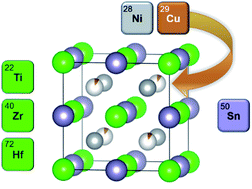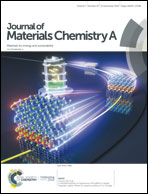Suppression of thermal conductivity without impeding electron mobility in n-type XNiSn half-Heusler thermoelectrics†
Abstract
We outline a strategy to improve the thermoelectric performance of n-type XNiSn based half-Heusler alloys through Cu doping into vacant tetrahedral sites. A comprehensive combination of structural characterisation and modelling is employed to discriminate the competing mechanisms for thermoelectric enhancement. During synthesis a mineralising effect occurs that improves the homogeneity of the alloying elements Ti, Zr and Hf, and promotes grain growth, leading to a doubling of the electron mobility. In the formed materials, Cu is a strong n-type dopant, like Sb, but occupies the interstitial site and strongly enhances phonon scattering without diminishing carrier mobility (in contrast to interstitial Ni). Simultaneous alloying with Ti, Zr and Hf serves to minimise the thermal conductivity via regular mass disorder and strain effects. A best electronic power factor, S2/ρ, of 3.6 mW m−1 K−2 and maximum ZT of 0.8 at 773 K were observed for a Ti0.5Zr0.25Hf0.25NiCu0.025Sn composition, enabling promising device power densities of ∼6 W cm−2 and ∼8% conversion efficiency from a 450 K gradient. These findings are important because they provide new insight into the mechanisms underpinning high ZT in the XNiSn system and indicate a direction for further improvements in thermoelectric performance.



 Please wait while we load your content...
Please wait while we load your content...